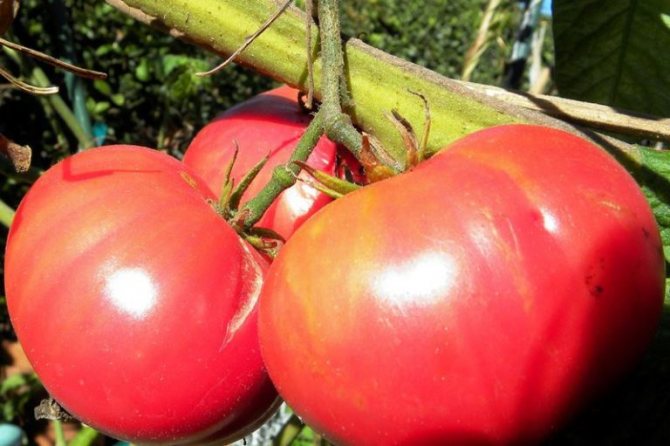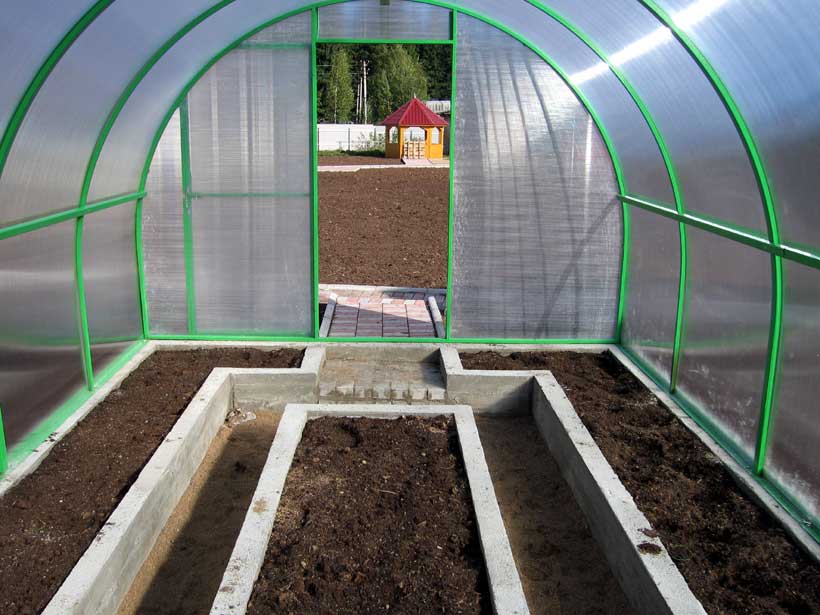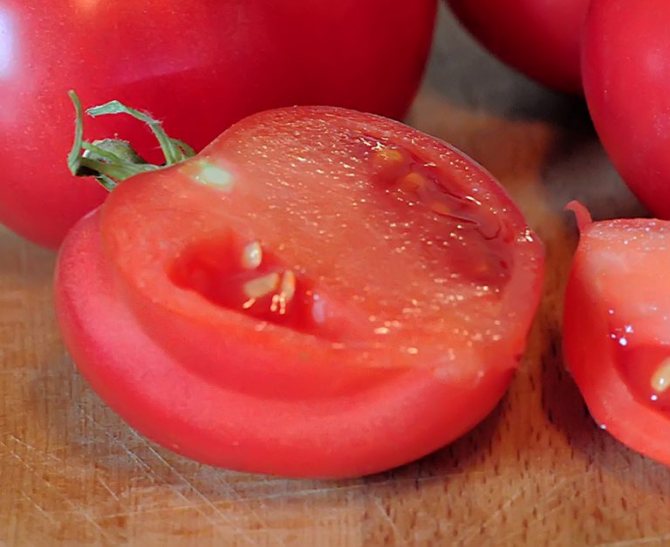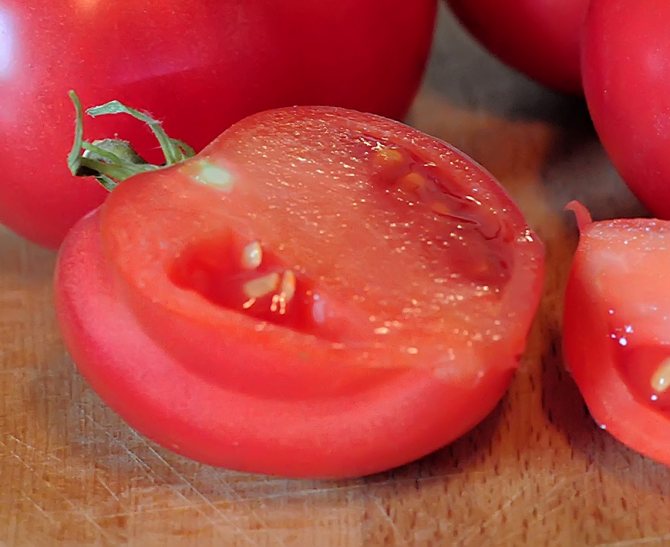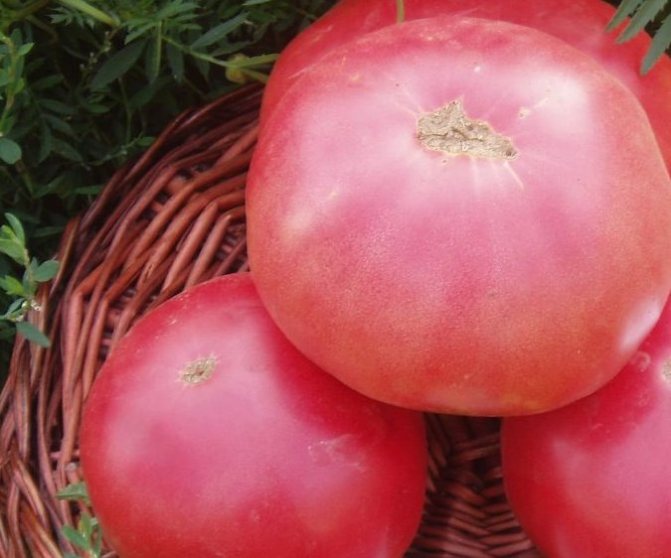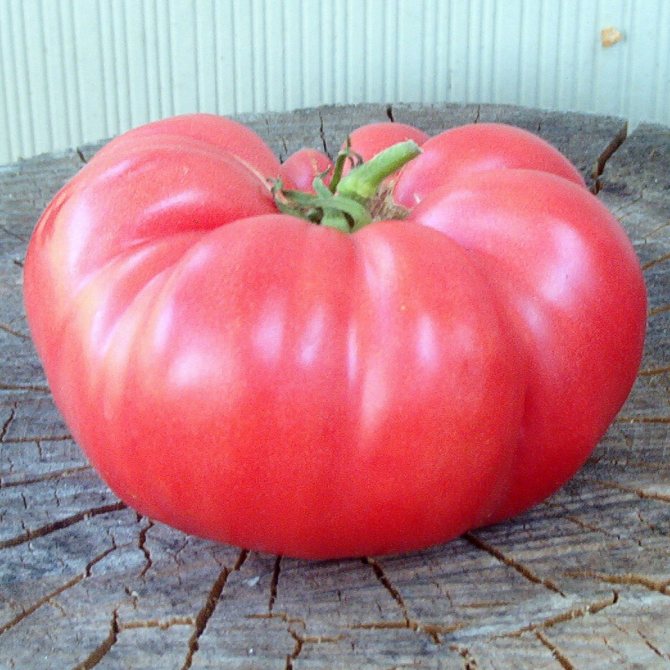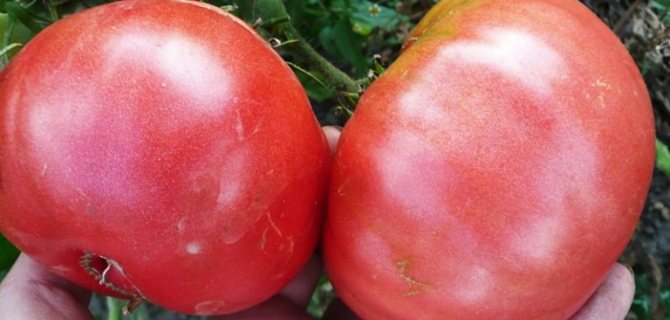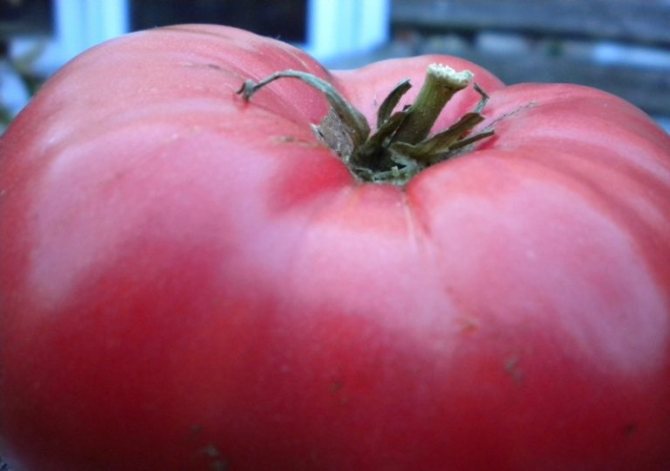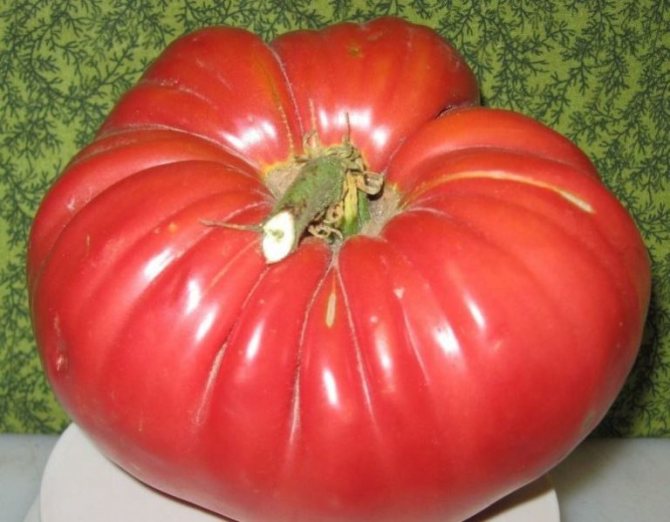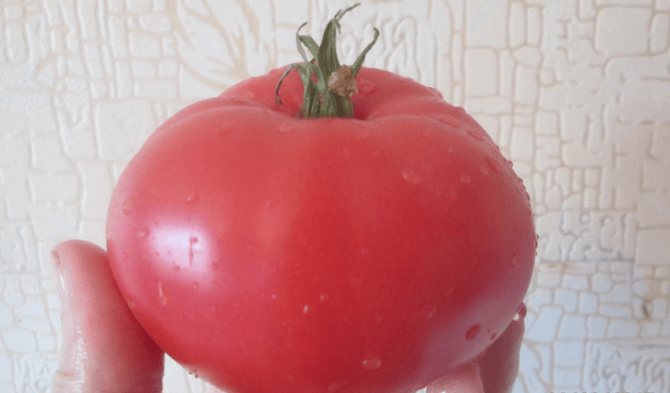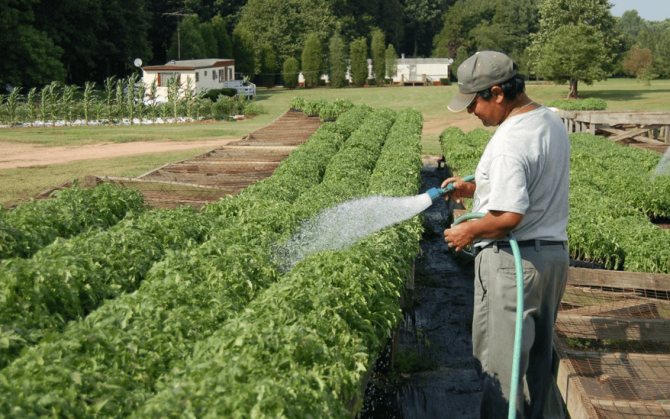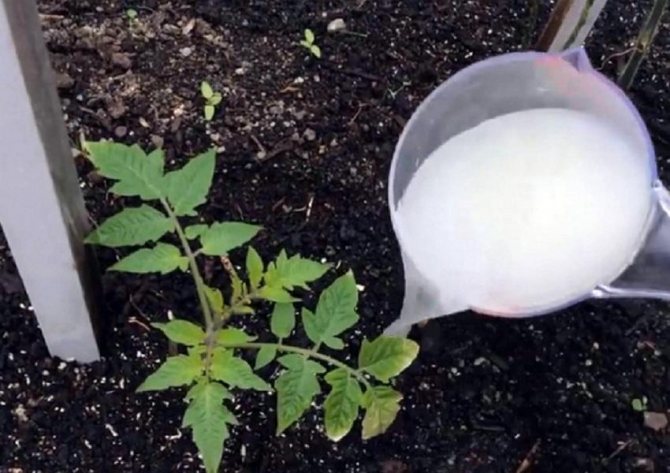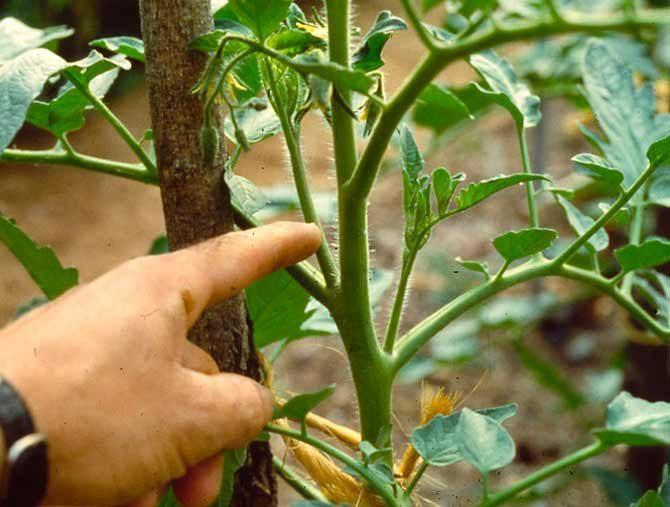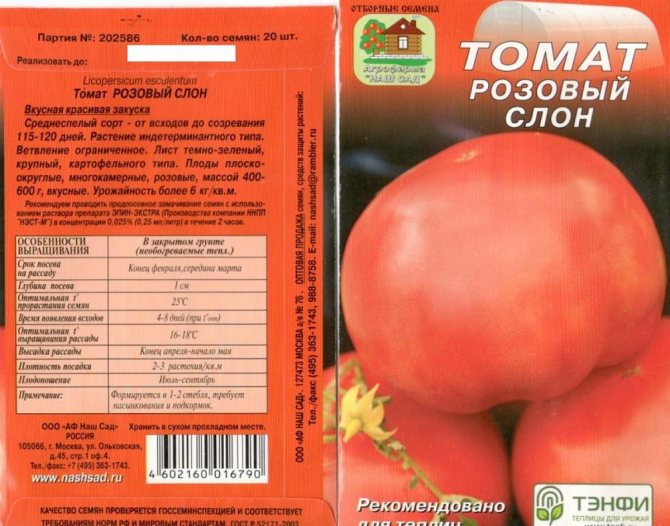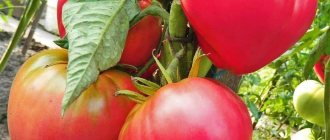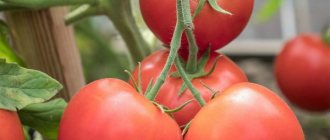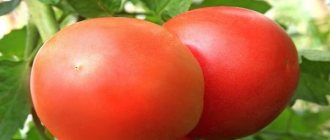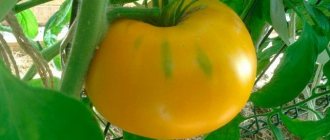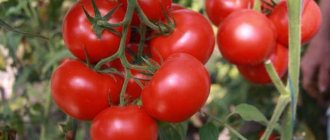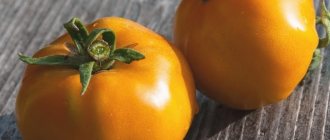Category: Tomatoes
Tomatoes Pink Elephant, reviews with photos, as well as recommendations for the cultivation of which are presented below, got their name due to the exceptional size of the fruits, the average weight of which is 300 g.
- Tomato variety Pink elephant (video)
- Cultivation of the Pink Elephant variety
- Pink tomatoes (video)
- Watering Tomatoes Pink Elephant
- Reviews of gardeners
Description and characteristics of the tomato
It is difficult not to pay attention to this tomato, the bush is tall, and the tomatoes themselves are distinguished by an enviable size.
Appearance
The variety has a medium early ripening period, from germination to fruit emergence takes an average of about 3–3.5 months. The bush is high, voluminous, can grow up to 1.5–1.7 m in height. Leaves are medium in size, dark green in color, inflorescences of intermediate type. Tomatoes are large, pink in color, collected in clusters of 3-4 pieces. The weight of one tomato can range from 300 g to 3 kg. The shape is rounded, flattened on top, ribbed at the stalk. There are four seed chambers, there are few seeds inside. The pulp of a tomato is juicy, sweet, the skin is firm, soft.
Origin of the variety
The Pink Elephant variety, sometimes called raspberry, was bred by Russian scientists in 1998. At first, these tomatoes were intended for greenhouses.
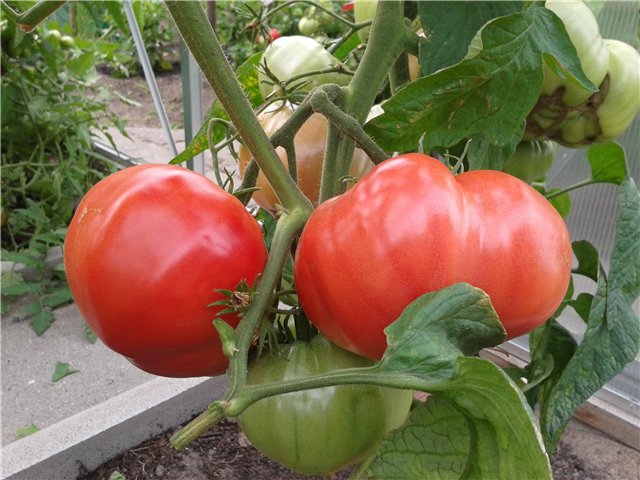
Landing region
The variety can be grown in different regions both outdoors and in greenhouse conditions.
Disease and pest resistance
The variety is resistant to most diseases, as well as pests of the nightshade family, but there is a danger of damage by late blight.
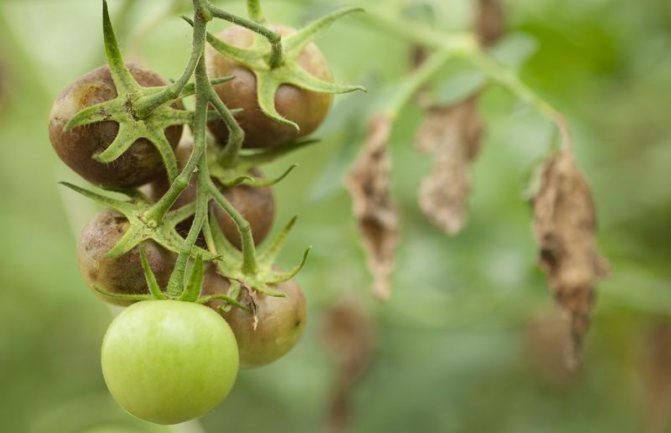

Ripening time and yield
Tomato Pink Elephant belongs to varieties with an average ripening period, which means that at least 110–120 days will pass from germination to fruit emergence. With good care, the yield can be up to 8 kg of sweet fruits from one plant.
Reviews of gardeners
Everyone who planted this variety on their site leaves positive reviews about it. The special advantage of the Pink Elephant tomato variety is its high taste characteristics. Thanks to this, despite not the highest yield, the variety does not lose popularity.
To carry out self-collection of seed and subsequent pre-planting processing, you need to know the intricacies of this process. Many vegetable growers prefer to buy seeds from proven ones, "Gavrish"), which do not need preparatory procedures.
Pros and cons of the variety
These tomatoes, in addition to large fleshy fruits, have other, no less significant advantages.
Pros of Pink Elephant tomatoes:
- large fruit size;
- excellent taste;
- can be eaten fresh, used for preservation;
- good yield - 3-4 kg per bush;
- transportability;
- keeping quality;
- resistance of tomatoes to fungal diseases, to pests.
Minuses:
- constant care of the bush is necessary;
- you need regular watering and feeding;
- a certain temperature regime is required;
- very heavy brushes during fruit ripening, a garter is required;
- the fruit may crack.
Advantages and disadvantages
The Pink Elephant tomatoes have both advantages, for which they are valued by gardeners, and disadvantages that discourage summer residents from growing it. Among the advantages of the variety are:
- resistance to late blight in comparison with a number of other growing varieties;
- good immunity to Alternaria;
- the variety has resistance to pest attack;
- long fruiting period - fruits can be harvested until autumn;
- large fruits with excellent taste;
- long shelf life thanks to the firm but delicate pulp.
The variety is not without its drawbacks, which should be known by those who decided to try to grow it:
- the need to form a bush;
- capriciousness in relation to care: proper watering, top dressing, adherence to temperature conditions.
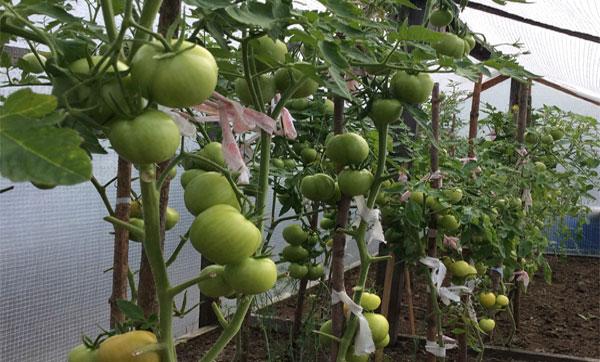

Growing Tomatoes Pink Elephant
The cultivation of this variety is not much different from the cultivation of tomatoes in general, but there are some subtleties here.
Features of planting seedlings
Seeds for seedlings are sown 60-65 days before planting in the ground, pretreated with potassium permanganate, and then placing a growth stimulant, such as Kornevin, in the solution.
See also Tomato variety Dubrava: yield and cultivation features
Pots or boxes with drainage holes and a pallet are taken as containers. The composition of the potting mix should be as follows:
- garden land;
- humus;
- river sand;
- wood ash.
Expert opinion
Stanislav Pavlovich
Gardener with 17 years of experience and our expert
Ask a Question
If you plan to use the land from your garden, it must be disinfected with a weak solution of potassium permanganate.
Tomato seeds are placed in a substrate at a distance of about 3 cm from each other, buried in a pencil, carefully sprinkled with soil, sprayed with warm water and covered with glass or foil. The boxes are placed in a warm place with an ambient temperature of about +20 ° C. After 10 days, sprouts appear.
Seedling lighting
Hatching tomatoes need lighting 12 hours a day. To provide such conditions, you will need to purchase special lamps, also called phytolamps. Since the photosynthesis process deteriorates with a lack of light, the seedlings begin to stretch and bend.
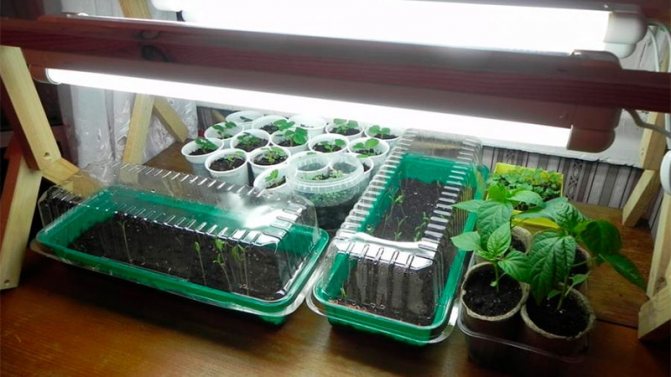

Picking
Tomato seedlings dive into cups when two true leaves appear. Thus, the plant will have 4 leaves: two cotyledons and two ordinary ones. It is recommended to add mineral fertilizer to the substrate before planting, at the rate of a tablespoon per 5 liters of soil. Seedlings are carefully dug out, trying not to damage the stem, the central root is shortened by two-thirds. Depressions are made in pots and seedlings are placed there almost to the very leaves, then the earth is slightly tamped, the tomatoes are watered and transferred for three days to a shaded room.
Hardening of seedlings
Tomatoes are hardened about two weeks before planting. The pots are taken out on the veranda, terrace or balcony, where the temperature should be about 12-15 ° C, at first for one hour, then the time is gradually increased. Hardening will strengthen the tomatoes, prepare them for open ground.
Landing in the ground
By this time, the stems of the seedlings reach 1 cm in diameter, and the height of the bushes is already about 30 cm.
The soil for tomatoes is prepared in the fall, dug up, fertilizer, rotted manure or compost is applied, humus and vermicompost are also suitable. A week before planting, the garden bed is dug to the depth of a shovel bayonet, loosened, and weeds are removed.
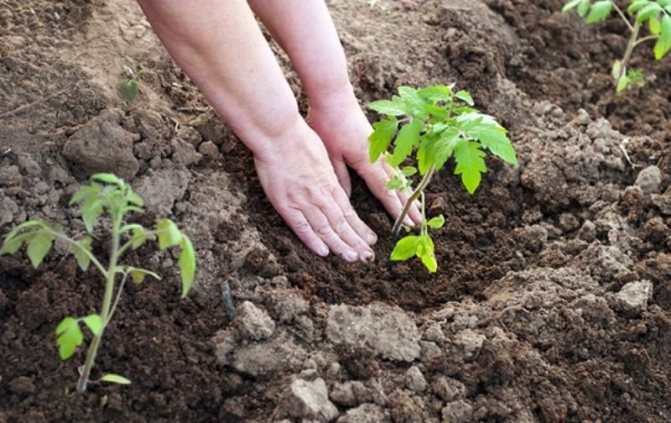

Tomatoes are planted towards the end of April - in the southern regions, and by the end of May - beginning of June in the Volga and Central districts, when the risk of recurrent frosts has passed. They do it as follows:
- Dig holes in two rows, the gap between the holes is 40 cm, between the rows, at least 50 cm.
- Superphosphate or wood ash is poured there, mixed with garden soil.
- Watering.
- The seedlings are placed in holes and sprinkled with soil, you can deepen it by 10 cm or a little more.
- The earth is lightly tamped.
It must be remembered that tomatoes love sunny areas and do not tolerate stagnant water. It is good to plant siderites in the garden a couple of seasons before the tomatoes: lupine, alfalfa, mustard.
The subtleties of growing
Large-fruited tomatoes, including the Pink Elephant, need special attention from the gardener. In order for the variety to fully reveal its potential, it is necessary not only to water and weed the beds in a timely manner, but also to observe other rules of agricultural technology of this culture.
Planting a tomato
The pink elephant is most often grown through seedlings. Its sowing is carried out 65–70 days before the planned disembarkation at a permanent place. You can accelerate seed germination by soaking them for 2-3 hours in aloe juice or warm water with the addition of Epin (0.5 ml per 100 g of water). For growing seedlings, purchased soil for tomatoes and a mixture prepared in the fall of equal parts of humus and sod land with the addition of ash (1 glass per bucket) is perfect for growing seedlings.
Growing seedlings includes several stages:
- The prepared seeds are laid out on the surface of well-moistened soil and covered with a layer of earth 1 cm thick. For this purpose, it is convenient to use plastic disposable containers.
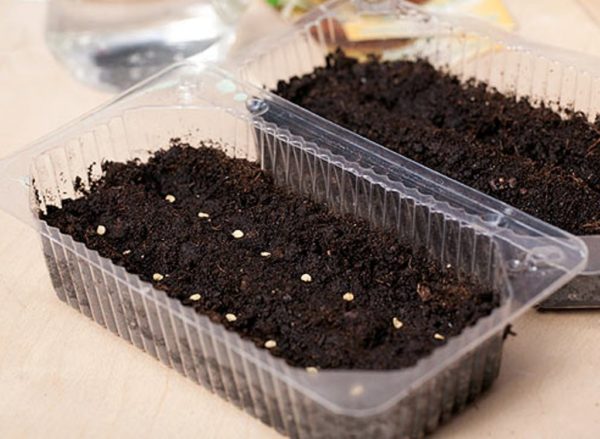

It is convenient to use plastic disposable containers for sowing tomatoes.
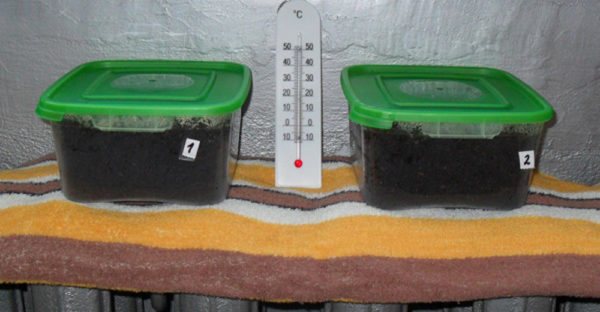

The central heating battery is the best place for seed germination
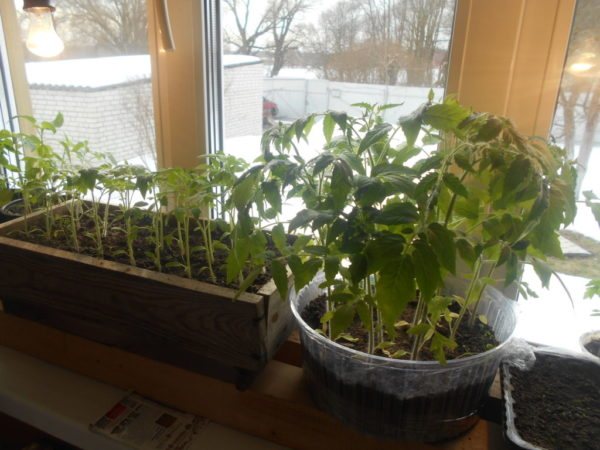

Tomato seedlings develop well only with enough sunlight.
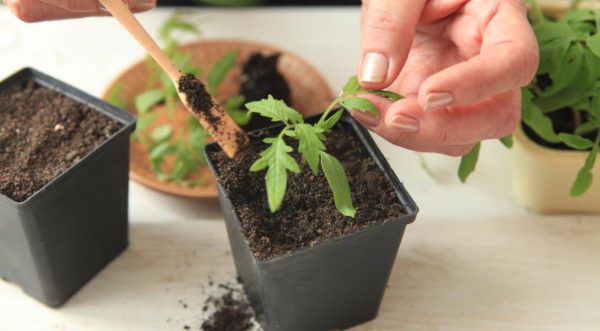

Picking helps to strengthen the root system of tomatoes
Seedlings are watered only after the lower leaves begin to lose elasticity.... It is important to avoid waterlogging. This can cause the development of a very dangerous disease - black leg.
The Pink Elephant requires a lot of nitrogen to grow quickly. To prevent its deficiency, regular application of complex fertilizers created specifically for seedlings (for example, Agricola or Fertik) will help. The first feeding with them is carried out a week after the pick, then it is repeated every 10-14 days.
The seedlings are planted in a permanent place after the ground warms up to + 15 ° C, and 5–7 leaves and at least one flower cluster are formed on the seedlings. The layout is 50 × 50 cm, or 4 plants per 1 m 2. If you plan to grow 2 or 3 stems, then the number of tomatoes per 1 m 2 is reduced to 2.
Adult plant care
The pink elephant needs the obligatory formation of the bush. This procedure significantly increases yields and accelerates fruit ripening. Seed growers recommend growing the variety in one stem, removing all stepchildren. With this method of formation, the top of the main shoot is not pinched and all the flower brushes formed on it are left.
Read also: Planting red currants, description of the Marmaladnitsa variety
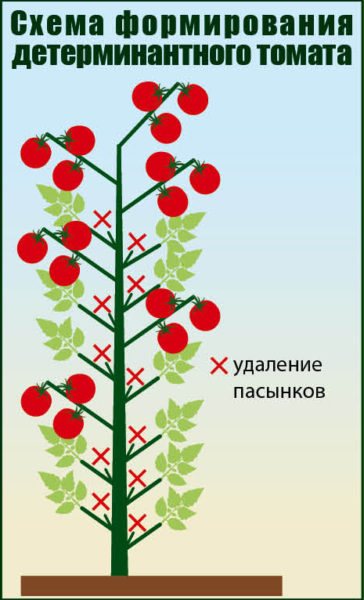

The formation of bushes of the Pink Elephant in one stem makes it much easier to care for them.
Some gardeners grow the Pink Elephant in 2-3 trunks, which increases the number of ovaries and lengthens the duration of fruiting. The main feature of this method is that in addition to the main stem, 1-2 lateral stepsons are left on the bush, which have grown from the lowest leaf sinuses. All other shoots, including those grown on additional stems, must be removed.
Unfortunately, diseases do not bypass this variety. Late blight is especially dangerous for him - a fungal infection that develops with high humidity and lack of heat. To combat it, plants are treated with such fungicidal preparations as:
The treatment of tomato bushes with chemical agents is stopped after the formation of ovaries.
Used to prevent the development of late blight and folk remedies. For example:
- Garlic infusion. 200 g of garlic (both heads and green parts of the plant can be used) are chopped and poured into 2 liters of water. After 2 days, the infusion is filtered and diluted with water so that about 10 liters of water are obtained.To enhance the effect, add 1/2 tsp to it. potassium permanganate and a little laundry soap.
- Milk and fermented milk products (kefir or whey). They are diluted with water in a ratio of 1:10, adding a few drops of iodine.
- A solution of iodine (5 mg per 10 L of water) or salt (1 glass per bucket).
Plants are sprayed with solutions prepared without the use of chemicals throughout the growing season at intervals of 2-3 weeks.
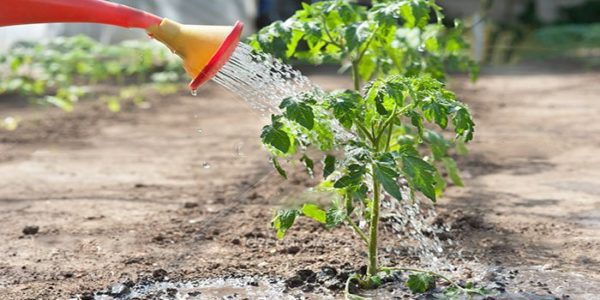

The Pink Elephant variety needs regular watering
Abundant fruiting of the Pink Elephant variety is impossible without sufficient water and nutrients. But it is important to observe the measure. Excessive moisture often leads to cracking of the fruit and can cause the development of fungal diseases, therefore, plants are watered only after the soil dries out, preventing water from getting on the green parts of the bush.
To increase the yield, plantings are fed with complex fertilizers for tomatoes 1-2 times a month:
They can be replaced with self-prepared bread kvass. The finished infusion is diluted with water in a ratio of 1: 5 and used for irrigation. The first time bread kvass is used immediately after fruit setting. Further feeding is repeated 2-3 times per season.
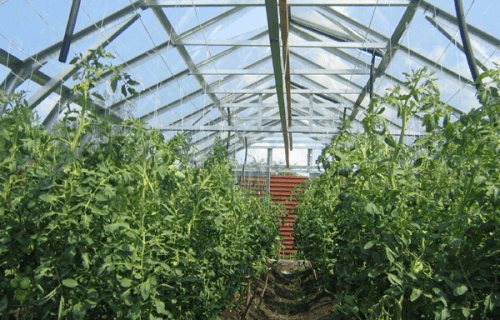

When growing tomatoes in a greenhouse, there may be problems with their pollination.
Gardeners often complain about the poor pollination of the Pink Elephant when grown in greenhouses. The following measures will help to cope with this problem:
- observance of a temperature regime favorable for pollination (from + 13 ° C to + 30 ° C);
- leaving the vents open so that insects pollinating tomatoes can enter;
- planting between rows of plants that attract bees and other pollinating insects, for example, basil or marigolds.
If necessary, tomatoes can be manually pollinated by shaking the plants slightly. A brush or toothbrush is also used to transfer pollen.
Further care of the culture
This variety needs support and a garter; it is most convenient to grow tomatoes on trellises. This method will prevent damage to the plant, bending under the weight of large fruits.
Look also Specific of cultivation and characteristics of tomato Malachite box
Fertilization
It is enough to apply mineral fertilizers twice during the growing season. If organic matter is preferred, the amount of dressings can grow to five.
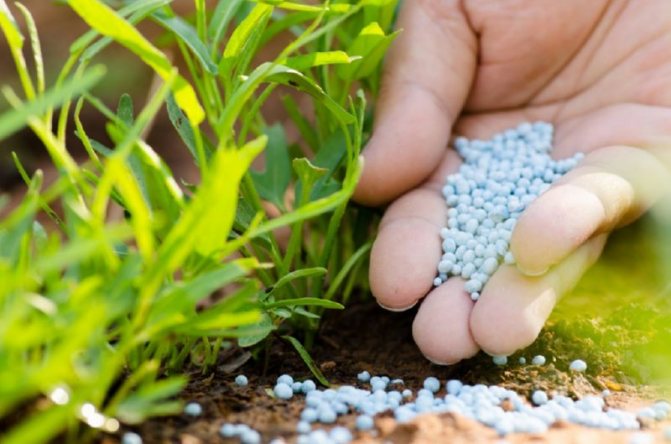

Watering rules
Before rooting, tomato seedlings need to be moistened daily. Then it is watered three times a week, under the root, focusing on the weather conditions. Water for irrigation must be warm, settled, watering can - with a fine-mesh nozzle.
Soil loosening
After watering, the soil at the roots should be loosened to prevent crust formation and provide oxygen to the roots.
Stepping
Since the bush of the Pink Elephant variety can grow very tall and lush, pinching of this tomato is one of the mandatory procedures, otherwise all the forces of the plant will go to the formation of tops, which will negatively affect the harvest.
Expert opinion
Stanislav Pavlovich
Gardener with 17 years of experience and our expert
Ask a Question
Stepsons are removed at an early stage, without waiting until they reach more than 2 cm in length.
Forming a bush
A bush is usually left with one stem with four brushes or two stems with two or three. The growth point must be pinched through the sheet after the upper brush.
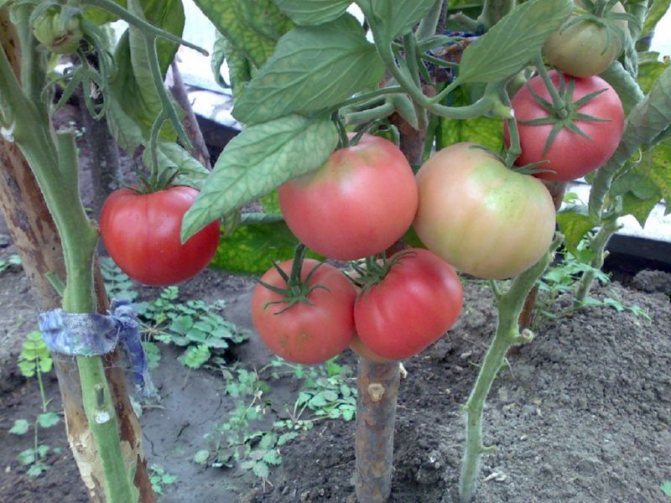

How to grow seedlings
Another feature of the "Pink Elephant" is growing only by seedlings. regardless of climatic conditions.
Seed preparation
The step-by-step steps for preparing seeds for planting are:
- At the beginning of March, it is necessary to start preparing seeds for seedlings, so that they can be sown in the second half of the month. In warm regions, seeds begin to be prepared earlier, respectively, and plant too.To begin with, process the material purchased or prepared from the last harvest in a solution of potassium permanganate for about 30 minutes. We throw out the floating seeds, they will not sprout.
- After processing with potassium permanganate, rinse them under running water.
- Dry the resulting seeds.
- In order for the harvest to succeed, feeding should start from the seeds. Before sowing, we treat the seeds with growth stimulants, for example, such as Immunocytofit, Agat-25K, or a natural stimulant - aloe.
- Germination of seeds, in turn, consists of the following stages:
- pour water into a shallow plate, place cheesecloth or other cotton material;
- put seeds;
- cover with the same material;
- watch when the seeds break through.
Capacity and soil
For planting germinated seeds, it is recommended to prepare:
- thin plastic containers with lids;
- deep containers with a pallet and drainage.
Use a commercial soil recommended for sowing peppers and tomatoes., or you can mix the soil in which the seedlings will be planted with ash, humus and sand (ratio 2: 1: 1: 1).
Protection against diseases and pests
Black leg is a disease of tomato seedlings, provoked by bacteria or fungi, is almost impossible to treat and can destroy all crops. Therefore, it is so important to prevent infection. For this you need:
- dressing seeds before planting;
- disinfect the soil mixture by calcining in the oven;
- avoid excessive soil moisture and excess nitrogen;
- provide good illumination.
To prevent the disease of tomatoes with gray rot, it is unacceptable to overmoisten the soil, and weeds must be removed in time.
Expert opinion
Stanislav Pavlovich
Gardener with 17 years of experience and our expert
Ask a Question
If dark spots were found on the fruits, it is possible that the tomatoes were struck by late blight. The diseased parts of the plant are removed, the rest are treated with Bordeaux liquid; at the initial stage, spraying with a furacilin solution can help.
Of insects, tomatoes can be harmed by the whitefly, the Colorado potato beetle, spider mites, and aphids.
To destroy parasites, the bushes are sprayed with "Aktara", "Fitoverm". From folk remedies, spraying with an infusion of garlic, tobacco, a mixture of ash with laundry soap helps.
Harvesting and application of the crop
The fruits of the "Pink Elephant" are used mainly fresh.... They are also used for the preparation of canned preparations - lecho, juices, pastes.
The harvest is not stored for a long time... Tomatoes are put in boxes and stored in a dry, dark place. It is important that the tomatoes themselves are also dry.
Reference. Ripe fruits are removed from the bush in the early morning. Gardeners note that if you remove green or brown fruits, then after ripening on the windowsill, they will not lose their taste.
Bush formation
What will be the harvest at the end of the season? It all depends on the power and size of the bush. The formation of a plant requires special attention and diligence of the gardener, since tomatoes can grow strongly.
From the axils of each leaf, the bush throws out stepchildren, who form new stems, and those, in turn, a new "generation" of stepchildren. It is important to intervene in time so that the plant does not waste energy on the formation of green mass. Another harm is that the leaves will shade each other, which can cause some diseases. Tomato variety "pink elephant" needs the help of a gardener.
This plant is a semi-determinate variety that is best formed into two stems. Although some gardeners prefer to grow a shrub with a single shoot. In this case, the "pink elephant" tomato reaches a height of 1.6 m. When forming, three points are taken into account.
- Leave the stepson under the first flower brush and get the second stem from it.The newly formed shoot plays an important role: at a certain stage of development, the main stem may stop growing, and then an additional shoot replaces it. It begins to grow more intensively, and the plant continues to set fruit. But if the main stem does not stop growing, then over time the additional one is broken off.
- It is necessary to gradually remove the leaves, starting from the ground and down to the bottom brush. Moreover, this must be done before the first fruits appear. To prevent the plant from hurting, remove 1-2 leaves a week.
- In the two lower inflorescences, 4 flowers should be left, and the rest should be carefully torn off.
For tomatoes, you need to create strong support and take care of high-quality fixing material. Some summer residents have learned from their own experience that ropes are not quite a suitable option. The bush begins to fall, as it cannot withstand the weight of the fruit. For growing tomatoes with such heavy fruits, it is better to build a stable structure.
The implementation of such agrotechnical actions helps to achieve a record weight of fruits, sometimes up to 1 kg.
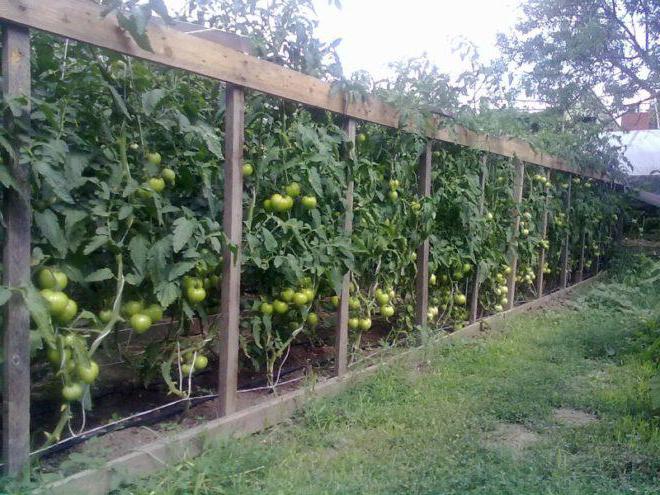

Planting seedlings to a permanent place
It is impossible to indicate the exact time of planting seedlings in open ground, since weather conditions are changeable. Repeated frost must be avoided. These conditions usually occur in mid-May (depending on the region). It is recommended to keep a film in stock to cover the seedlings in case of a sharp drop in temperature. It is possible to plant seedlings in a heated greenhouse earlier, for example, in April.
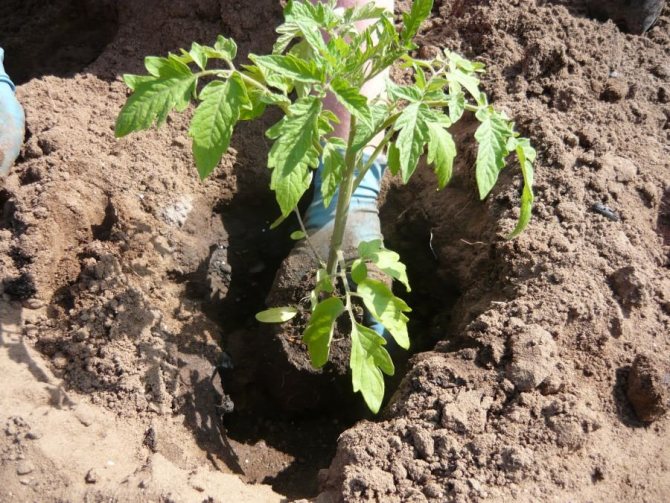

Planting frequency of "Pink Elephant" should not exceed 2-3 seedlings per m². Leaving a row spacing of 50 cm, the gaps between such bushes will be about 40–45 cm. The planted seedling is watered with warm water.

